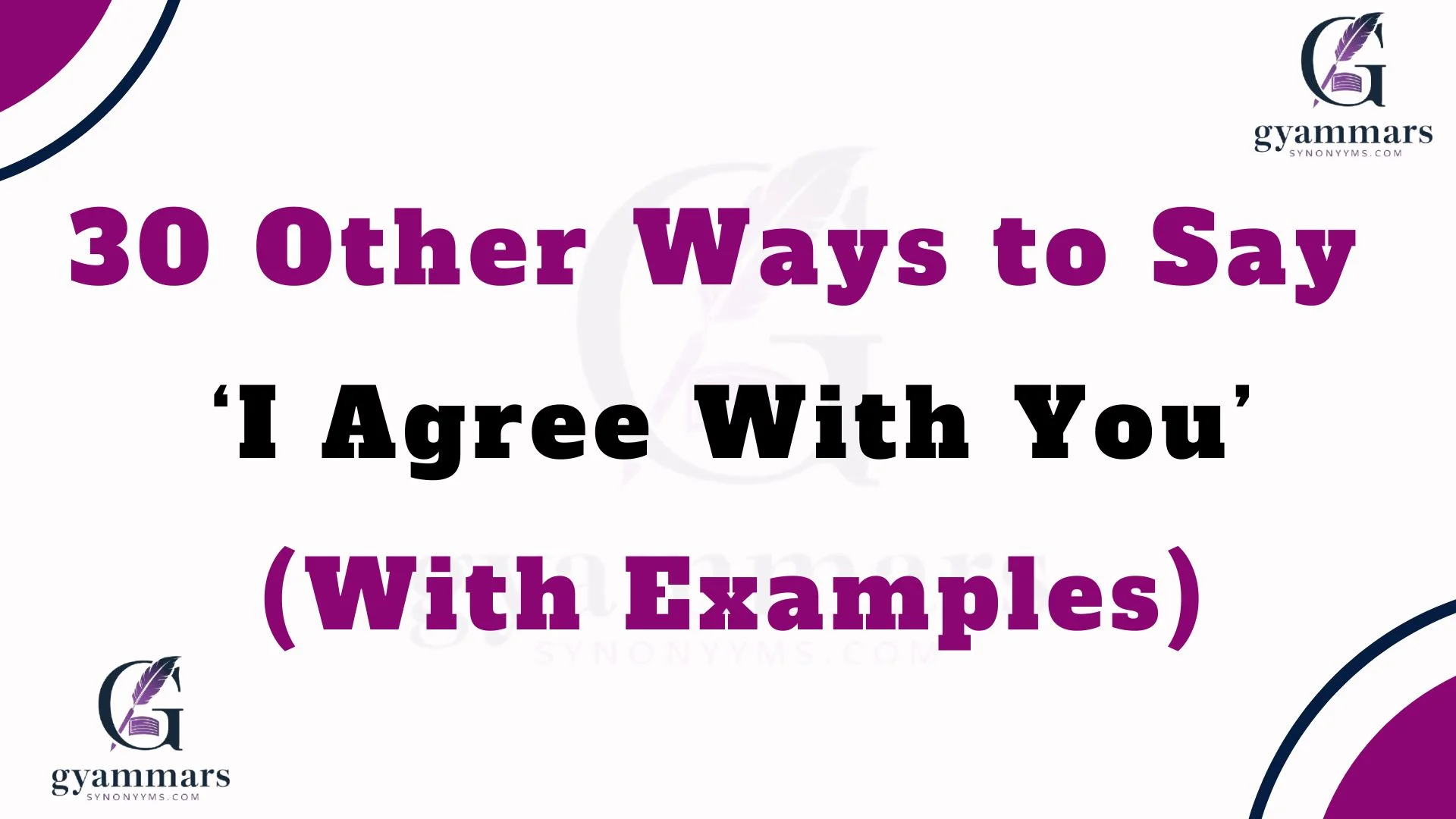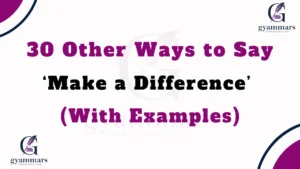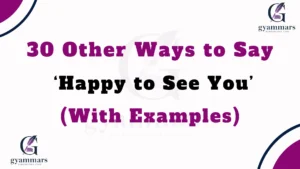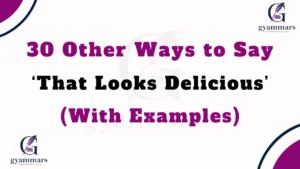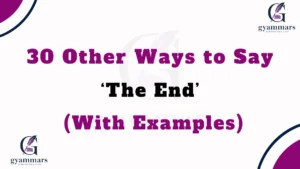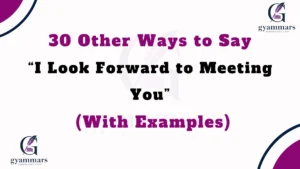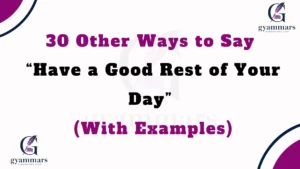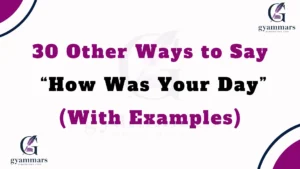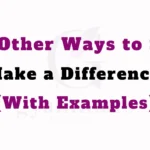Finding the right words to show agreement isn’t just about saying “yes.” In formal conversations—whether at work, in meetings, or professional emails—the way you phrase your agreement can reflect your respect, empathy, and attentiveness. Choosing thoughtful alternatives to “I agree with you” can help you sound polished, professional, and caring, while still affirming the other person’s point of view.
In this guide, you’ll discover 30 formal alternatives to “I agree with you,” complete with definitions, explanations, examples, and best uses so you can communicate with warmth and precision.
What Does “I Agree With You” Mean?
When someone says “I agree with you,” they’re expressing that their thoughts or opinions align with yours. It’s a way to validate and support another person’s perspective, showing unity and understanding in conversation.
Is It Professional/Polite to Say “I Agree With You”?
Yes, it’s professional and polite to use the phrase, but it can sometimes feel too casual or repetitive in formal writing or professional discussions. That’s why having alternatives can help you adapt your tone to the situation.
Pros or Cons of Saying “I Agree With You”
Pros:
- Shows alignment and support.
- Simple and easy to understand.
- Works in both casual and professional contexts.
Cons:
- Can sound repetitive.
- May feel too informal in some formal or business contexts.
- Doesn’t always convey nuance or depth of agreement.
Synonyms For ‘I Agree With You’
- I Completely Agree
- I Strongly Agree
- I’m In Full Agreement
- I Concur
- That’s Correct
- Absolutely
- Without a Doubt
- Precisely
- Indeed
- That’s Exactly Right
- You’re Absolutely Right
- I Second That
- I Endorse That View
- That Makes Perfect Sense
- You’re Spot On
- I’m With You on That
- Exactly
- I’m of the Same Opinion
- I Share Your View
- I Am in Accord
- You Have a Point There
- I Think So Too
- That’s True
- I’m On Board
- That’s Valid
- That’s a Fair Point
- I Respectfully Agree
- That Resonates With Me
- I Affirm That
- I Align With That
1. I Completely Agree
Definition: Full agreement without reservation.
Explanation: This phrase emphasizes total alignment with someone’s viewpoint.
Scenario Example:
- “I completely agree with your strategy for the project—it’s practical and effective.”
Best Use: Formal meetings, professional discussions, or written emails.
Tone: Strong, confident, supportive.
Additional Notes: Use when you want to show full, enthusiastic support.
2. I Strongly Agree
Definition: Expresses firm and solid support.
Explanation: Adds emphasis compared to a simple “I agree.”
Scenario Example:
- “I strongly agree that we should prioritize customer feedback in our next update.”
Best Use: Use in professional debates or when you want to stress your position.
Tone: Formal, decisive.
Additional Notes: Shows conviction.
3. I’m In Full Agreement
Definition: Formal way of saying you agree entirely.
Explanation: Sounds polished and professional, often used in formal writing.
Scenario Example:
- “I’m in full agreement with the proposed timeline adjustments.”
Best Use: Professional reports, legal or official settings.
Tone: Neutral, authoritative.
Additional Notes: Works well in documents.
4. I Concur
Definition: Formal synonym of “I agree.”
Explanation: Common in business, academic, or legal discussions.
Scenario Example:
- “I concur with your analysis of the market trends.”
Best Use: High-level meetings, formal emails.
Tone: Professional, intellectual.
Additional Notes: Avoid in casual conversations—it may sound stiff.
5. That’s Correct
Definition: Acknowledges correctness in someone’s statement.
Explanation: Focuses on accuracy more than agreement.
Scenario Example:
- “That’s correct—I reviewed the same data and reached the same conclusion.”
Best Use: Technical discussions, fact-checking, or formal validation.
Tone: Neutral, precise.
Additional Notes: More factual than emotional.
6. Absolutely
Definition: A strong, emphatic “yes.”
Explanation: Expresses certainty and full support.
Scenario Example:
- “Absolutely, your approach will lead us to better results.”
Best Use: Professional yet friendly contexts.
Tone: Positive, affirming.
Additional Notes: Works well in spoken conversations.
7. Without a Doubt
Definition: Leaves no room for uncertainty.
Explanation: Shows strong confidence in agreement.
Scenario Example:
- “Without a doubt, collaboration is the best path forward.”
Best Use: Motivational or persuasive discussions.
Tone: Confident, reassuring.
Additional Notes: More impactful in verbal exchanges.
8. Precisely
Definition: Expresses exact alignment.
Explanation: Indicates that someone else’s words perfectly reflect your thoughts.
Scenario Example:
- “Precisely—that’s exactly what I was thinking.”
Best Use: Formal discussions requiring accuracy.
Tone: Formal, sharp.
Additional Notes: Shows intellectual agreement.
9. Indeed
Definition: Reinforces agreement with emphasis.
Explanation: Adds weight to acknowledgment.
Scenario Example:
- “Indeed, your point highlights the importance of teamwork.”
Best Use: Formal writing, academic papers, or polite spoken responses.
Tone: Formal, polite.
Additional Notes: Old-fashioned but still effective.
10. That’s Exactly Right
Definition: Agreement with precision.
Explanation: Validates someone’s accuracy and viewpoint.
Scenario Example:
- “That’s exactly right—we need to move forward with this initiative.”
Best Use: Presentations, formal acknowledgments.
Tone: Clear, professional.
Additional Notes: Encourages the speaker.
11. You’re Absolutely Right
Definition: Affirms correctness directly to the person.
Explanation: Adds personal validation to agreement.
Scenario Example:
- “You’re absolutely right about the importance of efficiency.”
Best Use: Team discussions, one-on-one conversations.
Tone: Respectful, supportive.
Additional Notes: Builds rapport.
12. I Second That
Definition: To formally endorse a statement or proposal.
Explanation: Often used in meetings or parliamentary settings.
Scenario Example:
- “I second that motion regarding the budget increase.”
Best Use: Formal group discussions.
Tone: Professional, procedural.
Additional Notes: Very common in official settings.
13. I Endorse That View
Definition: To support someone’s perspective publicly.
Explanation: More formal than simply “agreeing.”
Scenario Example:
- “I endorse that view on sustainability as a long-term investment.”
Best Use: Business reports, speeches.
Tone: Formal, supportive.
Additional Notes: Best for formal, documented contexts.
14. That Makes Perfect Sense
Definition: Acknowledges logic and reasoning.
Explanation: Affirms that the idea is rational.
Scenario Example:
- “That makes perfect sense—we should prioritize this approach.”
Best Use: Analytical discussions.
Tone: Thoughtful, respectful.
Additional Notes: Shows understanding as well as agreement.
15. You’re Spot On
Definition: Informal-formal mix; means someone is exactly right.
Explanation: Encourages and validates.
Scenario Example:
- “You’re spot on—the analysis matches my observations.”
Best Use: Team conversations, collaborative work.
Tone: Warm, affirming.
Additional Notes: Slightly casual, but acceptable in semi-formal settings.
16. I’m With You on That
Definition: Expresses shared viewpoint.
Explanation: Communicates solidarity and alignment.
Scenario Example:
- “I’m with you on that—it’s definitely the best approach.”
Best Use: Professional but friendly exchanges.
Tone: Collaborative, empathetic.
Additional Notes: Shows teamwork spirit.
17. Exactly
Definition: Strong affirmation of precision.
Explanation: Simple but powerful.
Scenario Example:
- “Exactly—that’s the core issue we need to solve.”
Best Use: Concise, quick affirmations in discussion.
Tone: Direct, firm.
Additional Notes: Effective in spoken exchanges.
18. I’m of the Same Opinion
Definition: A formal way to express shared views.
Explanation: Polished alternative to “I agree.”
Scenario Example:
- “I’m of the same opinion regarding the new policy.”
Best Use: Formal emails or reports.
Tone: Professional, polite.
Additional Notes: Good for written communication.
19. I Share Your View
Definition: Expresses solidarity in perspective.
Explanation: Highlights common thinking.
Scenario Example:
- “I share your view on focusing on long-term goals.”
Best Use: Professional settings, collaborations.
Tone: Warm, respectful.
Additional Notes: Strengthens professional relationships.
20. I Am in Accord
Definition: To be in harmony with someone’s opinion.
Explanation: Very formal phrasing.
Scenario Example:
- “I am in accord with your interpretation of the data.”
Best Use: Academic or legal contexts.
Tone: Formal, serious.
Additional Notes: Rare but effective in the right setting.
21. You Have a Point There
Definition: Recognizes validity in someone’s statement.
Explanation: Doesn’t mean full agreement but acknowledges correctness.
Scenario Example:
- “You have a point there—we should consider that factor.”
Best Use: Constructive discussions.
Tone: Respectful, thoughtful.
Additional Notes: Good for nuanced agreement.
Alos Read This : 30 Other Ways to Say ‘Good Morning’ (With Examples)
22. I Think So Too
Definition: Shows shared thought process.
Explanation: A softer alternative to “I agree.”
Scenario Example:
- “I think so too—teamwork really is the key.”
Best Use: Semi-formal, friendly conversations.
Tone: Polite, supportive.
Additional Notes: Slightly casual but acceptable.
23. That’s True
Definition: Acknowledges correctness.
Explanation: Confirms alignment with the statement.
Scenario Example:
- “That’s true—we’ve seen positive results from this strategy.”
Best Use: Simple professional conversations.
Tone: Neutral, affirming.
Additional Notes: Works well in everyday dialogue.
24. I’m On Board
Definition: Shows readiness to support or act.
Explanation: Implies agreement plus willingness to participate.
Scenario Example:
- “I’m on board with the new project plan.”
Best Use: Workplace collaborations.
Tone: Cooperative, motivated.
Additional Notes: Dynamic and engaging.
25. That’s Valid
Definition: Recognizes legitimacy of a statement.
Explanation: Affirms that someone’s idea is reasonable.
Scenario Example:
- “That’s valid—your concern is important to address.”
Best Use: Professional debates, negotiations.
Tone: Respectful, professional.
Additional Notes: Neutral and open-minded.
26. That’s a Fair Point
Definition: Recognizes the fairness of an argument.
Explanation: Indicates balanced acknowledgment.
Scenario Example:
- “That’s a fair point—we need to reconsider our priorities.”
Best Use: Constructive discussions.
Tone: Respectful, empathetic.
Additional Notes: Works well when you partly agree.
27. I Respectfully Agree
Definition: Acknowledges agreement with added politeness.
Explanation: Used to maintain formal decorum.
Scenario Example:
- “I respectfully agree with your recommendations.”
Best Use: Diplomatic or sensitive contexts.
Tone: Formal, respectful.
Additional Notes: Great for delicate discussions.
28. That Resonates With Me
Definition: Expresses personal connection to someone’s words.
Explanation: Goes beyond agreement to show shared values.
Scenario Example:
- “That resonates with me—I believe we should prioritize people first.”
Best Use: Professional but empathetic discussions.
Tone: Warm, thoughtful.
Additional Notes: Builds deeper rapport.
29. I Affirm That
Definition: To confirm agreement formally.
Explanation: Polished and authoritative.
Scenario Example:
- “I affirm that the report aligns with our goals.”
Best Use: Legal, academic, or official contexts.
Tone: Formal, authoritative.
Additional Notes: Stronger than casual agreement.
30. I Align With That
Definition: Expresses harmony in values or direction.
Explanation: Indicates alignment beyond just agreement.
Scenario Example:
- “I align with that vision for the company’s growth.”
Best Use: Business strategy discussions.
Tone: Collaborative, professional.
Additional Notes: Suggests shared purpose.
Conclusion
Using thoughtful alternatives to “I agree with you” can elevate your communication, especially in formal or professional settings. Whether you choose “I concur,” “I completely agree,” or “I endorse that view,” your words can show not only agreement but also respect, empathy, and professionalism.

“Mia Rose at Grammar Synonyms is your ultimate guide to mastering language with style and precision. Whether you’re looking to enhance your vocabulary, perfect your grammar, or discover the ideal synonym, Mia Rose offers expert resources and creative solutions to help you express yourself flawlessly. With Grammar Synonyms, unlock a world of language possibilities and elevate every piece of writing you create.
